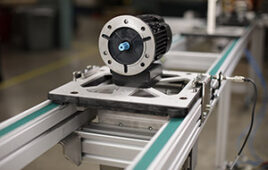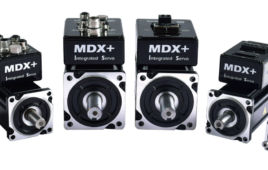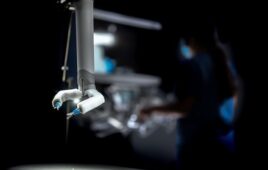When the thermal heat dissipation requirements of a design are very high, using an aluminum backed PCB is a highly effective solution. Aluminum backed designs are able to better translate thermal energy away from your design’s components and, therefore control the temperature of your design. Additionally, they are on the order of ten times more efficient at removing thermal energy from circuit components than the equivalent fiberglass backed board. This significantly higher level of thermal dissipation allows for higher power and higher density designs to be implemented.
Increasingly, aluminum backed PCBs are finding applications in high power/high thermal heat dissipation applications. Originally tasked for use in high power switching supply applications, aluminum backed PCBs have become very popular in LED applications including traffic lights, general lighting and automotive lighting. Their use allows for a higher density of LEDs in the board design and for the mounted LEDs to be driven at higher currents while still remaining within temperature tolerances. Using an aluminum backed design can allow designers to decrease the safety margin used with power LEDs and derate them less than with a conventional PCB design. As with all components, the lower the operating temperature of the LEDs in a design the longer those LEDs can be expected to operate before failing.
Other applications for aluminum backed PCB designs include high current circuitry, power supplies, motor controllers and automotive applications. They are an excellent thermal heat dissipation solution for any design that utilizes high power surface mount ICs. With the level of thermal dissipation provided by aluminum backed PCB designs can be simplified. An aluminum backed PCB can eliminate the need for forced air and heat sinking, then ultimately lower design cost. Essentially, any design that can be improved by higher thermal conduction and better temperature control is a possible application.
Whereas traditional PCBs use fiber glass substrates (FR4 is the standard substrate used by PCB fabricators), aluminum backing is a highly thermally conductive dielectric layer and a standard circuit layer. The circuit layer is essentially a thin PCB that has been bonded to the aluminum backing layer. As such, the circuit layer can be as complex as those mounted on traditional fiber glass backing.
While it is much more common to see single-sided designs, it’s also possible for an aluminum backed design to be two-sided, with a circuit layer attached through highly thermally conductive dielectric layer on both sides of an aluminum backing. These two-sided designs can then be connected by way of plated through holes. Regardless of the configuration, the aluminum backing provides an excellent thermal pathway to the surrounding environment or any attached heat sink improving thermal conduction from power components and, therefore, ensuring more reliable design.
The solder mask layer of the circuit portion of the board can be made a number of different colors as in traditional PCB designs although in LED designs the solder mask layer is typically white. A white solder mask allows for a higher level of light reflection from the associated LED array and produces a more efficient design. The solder mask is also commonly made black in power designs to better radiate heat (black being the best color for radiating energy). Image 2 shows a white solder mask aluminum backed PCB fabricated by PCBCART, one of leading PCB manufacturers based in China.
Aluminum backed PCB designs are also highly mechanically stable and lend themselves for use in applications that require a high level of mechanical stability or are subject to a great deal of mechanical stress. An additional benefit is that they are less subject to thermal expansion when compared with fiberglass based constructions. If your design doesn’t warrant high levels of thermal conduction, but the board will be subject to a great deal of mechanical stress and high heat, and has tight dimensional tolerances, the use of an aluminum backed design may be warranted.
Finally, aluminum is not the only metal backing material available. Copper and copper alloys, though not as popular due to their typically higher cost, are also used as a backing material. Copper and copper alloys offer an even higher level of performance with regards to thermal heat dissipation than aluminum. As such, if a standard aluminum backed design isn’t meeting the thermal heat dissipation demands of a design, using copper can be considered as a next step in resolving the issue.
In conclusion, using an aluminum backed solution can go a long way towards increasing the reliability and life time of a design through temperature control and the resultant low component failure rates. Along with excellent temperature control characteristics, aluminum designs also provide high levels of mechanical stability and low levels of thermal expansion. When standard fiberglass (FR-4) backed PCBs cannot satisfy the thermal dissipation and density requirements of your design, aluminum backed PCBs may provide the answer.
PCBCART offers quick-turn prototype through full production on a wide range of PCB manufacturing. The company can accommodate designs between two and 24 layers with an overall board thickness of up to 5 mm, as well as provide a small quantity of aluminum backed PCB turnkey solutions.
PCBCart
www.pcbcart.com.
The post Aluminum backed PCBs take the heat appeared first on Analog IC Tips.
Filed Under: MOTION CONTROL, Analog IC Tips






